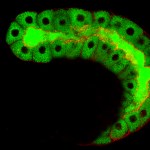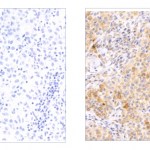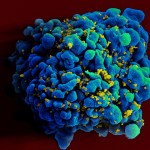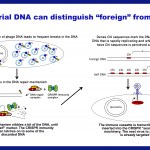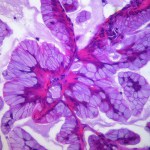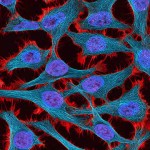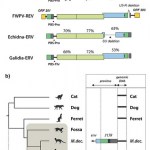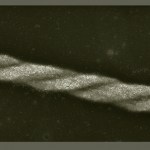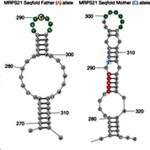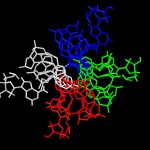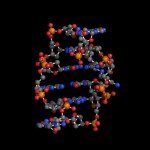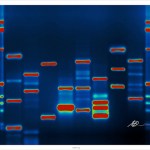DNA
Inspired by Karin Bojs's and Peter Sjölund's recent book Svenskarna och deras fäder, I've looked into my ancestry by means both genetic and genealogical. Here's a few highlights.
Like most Stockholmers, I'm of mixed rural Swedish stock. My great grandpa's generation contains 16 people born mainly in the 1880s. Only one of them was born in Stockholm. His parents were born in Värmland and Södermanland provinces. The other 15 were born all over rural southern Sweden: Bohuslän (two people), Småland (two people), Södermanland, Skåne and Närke. They went to Stockholm to find work, met and got…
Image of big eared bats By Stihler Craig, U.S. Fish and Wildlife Service [Public domain], via Wikimedia Commons
According to a press release from Northern Arizona University, Drs. Faith Walker and Carol Chambers at the Bat Ecology & Genetics Lab have developed a system called Species From Feces to identify bat species from guano collected in field locations such as mines, caves, bridges, etc. The system takes advantage of DNA sequencing technology and an assay to look for genetic identifiers unique to different species using DNA barcodes. The sequences can then be…
Don't let their small size fool you. Tardigrades, or 'water bears', are really tough animals. According to a review published in the American Scientist, these microscopic invertebrates can survive extreme variations in temperature from near absolute zero (-459 deg F) up to +302 deg F. They can also tolerate pressures that are 6 times greater than the deepest ocean, exposure to ionizing radiation (UV and x-ray) and the vacuum of space, as well as exposure to carbon dioxide and monoxide, nitrogen and sulfur dioxide. What's more, they can survive nearly…
Cells that “spit” out their contents and messenger RNA that is not so swift at delivering its message. Those are two brand new stories on our new and improved website. Check it out and let us know what you think.
The first story arose from a simple question: How do secretory cells – those that produce copious amounts of such substances as tears, saliva or all those bodily fluids – manage to get their contents out of the cell? Cells are walled all the way around; they don’t really have doors for letting things the size of a drop of fluid out. Instead, they use the vesicle system – small globes…
Over the last several months, a lot of great books on fossils and evolution (as in paleontology) have come out. I've selected the best for your consideration. These are great gifts for your favorite science-loving nephew, life science teaching cousin, or local school library. Actually, you might like some of these yourself.
Let's start off with a kid's book: Grandmother Fish: a child's first book of Evolution by Jonathan Tweet.
From the blurb:
Grandmother Fish is the first book to teach evolution to preschoolers. While listening to the story, the child mimics the motions and sounds of our…
Metastatic melanoma tumors. Left exhibits low or absent expression of RASA2 and reduced survival, typical of about 35% of patients. The sample on the right exhibits high RASA2 expression and increased survival
Rates of melanoma are increasing, even as the rates of other common cancers are decreasing. According to the Melanoma Research Alliance, it is the most common cancer diagnosis in young adults 25-29 years old in the United States, the second most common cancer in young people 15-29, and its incidence has tripled in the last 30 years.
What are we doing about it? The Weizmann Institute’…
On ERV, Abbie Smith provides an update on a pioneering treatment for hemophilia that uses viruses to insert missing genes in a patient's DNA. Hemophilia results from from the mutation or deletion of a gene that makes a blood clotting agent called Factor IX; without it, hemophiliacs are at risk for uncontrolled bleeding. While Factor IX can be delivered pharmaceutically, utilizing viruses to modify patients' DNA yields long-term improvements in natural Factor IX production. Abbie writes, "the amount of therapeutic Factor IX these patients needed (on average) dropped from 2613 IU/kg to 206. The…
Foreigner or native-born? Your immune system discriminates between them, as do those of bacteria. Yes indeed, bacteria do have immune systems – pretty complex ones at that. And like any useful immune system, the bacterial ones must have a good technique for distinguishing “foreign” from “self.”
You may even have heard of the bacterial immune system: It’s called CRISPR, and it’s used in biology research around the world for DNA engineering and genome editing. CRISPR normally inserts short DNA sequences taken from phages – viruses that invade bacteria – into special slots called spacers within…
Official New York City Subway Map
Dr. Christopher Mason (Weill Cornell Medical College, Manhatten, NY) decided to sequence DNA found in NY subway stations...468 of them to be precise. At each station, his research team collected DNA samples by swabbing the kiosks, turnstiles, benches, railings, trash cans as well as the subway cars.
Along with finding abundant Pseudomonas bacteria (also found on our skin) they discovered that the DNA at each of the stations reflected the amazing diversity of the local residents and what they were eating such as pizza, cucumbers, and chickpeas, which may…
This new year, researchers concluded that 2/3 of the difference in cancer risk between different parts of the body can be attributed to the number of stem cell divisions those parts undergo. More cell divisions reflect a higher risk as errors that occur naturally during the DNA replication process can contribute to the development of cancer. In other words, the same genetic mutability that enables evolution also ensures that many people will be afflicted by a terrible disease. On Pharyngula, PZ Myers suggests this is one reason our cells naturally get old and stop dividing:…
Every so often there's an article that starts making the rounds on social media, in particular Facebook and Twitter, that cries out for a treatment by yours truly. Actually, there are more such articles that are constantly circulating on social media that I could work full time blogging and still not cover them all. So I'm stuck picking and choosing ones that either (1) particularly pique my interest; (2) irritate me enough to goad me into action; or (3) reach a level of ubiquity that I can no longer ignore them. I don't think this one's hit #3 yet, but it certainly scores on #1 and #2.…
In a phenomenon known as Peto's paradox, large mammals do not develop cancer more often than small mammals, despite having more cells that could go haywire. On Life Lines, Dr. Dolittle writes "Some researchers suggested that perhaps smaller animals developed more oxidative stress as a result of having higher metabolisms. Others proposed that perhaps larger animals have more genes that suppress tumors." But a new hypothesis argues that large mammals have evolved to minimize the activity of ERVs, which are ancient viral elements integrated into our DNA. Active ERVs can cause cancer and possibly…
There are some myths, bits of misinformation, or lies about medicine that I like to refer to zombie quackery. The reasons are obvious. Like at the end of a horror movie, just when you think the myth is finally dead, its rotting hand rises out of the dirt to grab your leg and drag you down to be consumed. Of course, the big difference between zombies and these bits of zombie quackery is that in most stories a single shot to the brain will kill the zombie. The same is not true of zombie quackery. You can empty clip after clip of reason, science, and logic into the “head” of the zombie…
Image of seals from www.fanpop.com/clubs/the-animal-kingdom/images/14060694/title/seal-wall…
Paleogeneticist Dr. Johannes Krause (University of Tübingen, Germany) and colleagues were interested in the origin of tuberculosis (TB) in the Americas. Since strains of TB found in the Americas are related to strains found in Europe, prior theories held that Spaniards may have introduced it to the Americas while colonizing South America. The problem with those theories is that pre-Columbian skeletal remains showed signs of TB much earlier.
Dr. Krause was quoted in Scientific American, “…
Once again, there are three new pieces online on our website, each wonderful in its own way. But Haiku just didn’t seem to fit this batch. So, with apologies to the scientists, here are three limericks on the newest Institute research. As before, follow the links to get to our website.
(Incidentally, there is some precedent for limerick writing at the Weizmann Institute. The late Prof. Amikam Aharoni, who also wrote some serious stuff on ferromagnetism, was known for his limericks.)
The Quasar
There once was a baby black hole
That went for a short little stroll
It zigged and it zagged…
At the level of biomolecules, life boils down to two basic principles: sequence and folding. We know, for example, that the sequence of nucleotides in the DNA contains our genetic blueprint, but the way that our DNA is folded and wrapped up in each chromosome helps determine which genes are easily accessible for copying. Proteins – sequences of amino acids – fold into intricate shapes before assuming their duties. So it is no surprise that the third main molecular sequence in the cell – the RNA, made up of single strands of nucleotides – folds as well. Nucleotides are built to pair up – DNA…
Replication fork - http://en.wikipedia.org/wiki/Telomere.
Organisms with linear chromosomes have to solve the problem that DNA replication makes them shorter. This is due to the fact that DNA polymerase can only add bases to the terminal 3'-OH of a DNA chain. The DNA replication initiation complex uses RNA primers to provide the initial 3'-OH and to initiate "lagging" strand synthesis. While one strand can be copied all the way to the end of a chromosome, the other, lagging strand, must be primed at short intervals in order to provide a 3' OH group for DNA polymerase as the…
Today (4/25) is national DNA day. Digital World Biology™ is celebrating by sharing some of our favorite structures of DNA. We created these photos with Molecule World™ a new iPad app for viewing molecular structures.
As we are taught in school, the double stranded DNA molecule is a right-handed helix as determined by Watson and Crick using Franklin's x-ray diffraction images [1]. This B-form of DNA has approximately 10 nucleotides per turn of the helix and is the most common form of DNA found in nature.
Classic structure with the elements colored.
Classic structure…
The price of human genome sequencing has fallen spectacularly since the turn of the century; what then cost $100,000,000 is now promised for only $1000. This race toward zero makes even Moore's Law look like a snail's pace, but the $1000 price tag does come with a couple asterisks. For one, providers will need high demand to pay off the multi-million dollar sequencing array that makes it possible, and low demand should result in higher prices. For two, $1000 will only buy you a rough draft of your genome. On Discovering Biology in a Digital World, Todd Smith writes "While some…
Image of a great white shark from Wikimedia Commons.
Dr. Michael Stanhope from Cornell University has discovered that great white sharks actually share more proteins involved in metabolism and biochemistry in common with humans than zebrafish, a common fish model used in biomedical research. They made this discovery by sequencing the transcriptome of a heart isolated from a great white shark. I find it fascinating that sharks have more proteins in common with mammals than with bony fish, even though sharks and bony fish are not very closely related.
Source:
Cornell University Press
